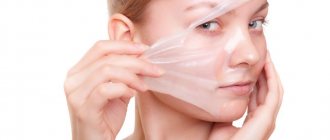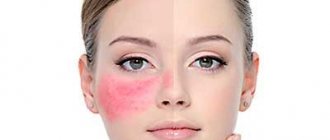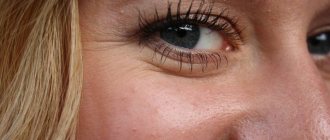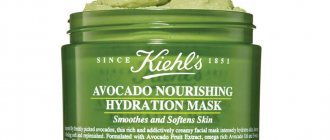Main principles of skin care after chemical peeling
Regardless of the type of peeling used and the degree of its penetration into the layers of the skin, there are a number of requirements that must be strictly observed during the recovery period.
Under no circumstances should you touch your face on the first day . This means that any procedures related to washing, applying moisturizers, etc. are prohibited. The only exceptions are special instructions from a cosmetologist regarding the specifics of the procedure itself. For example, with retinoic or yellow peeling, you will need to remove the product from your face yourself in strict accordance with the recommendations received. It is undesirable to touch your face in the following days, since injured skin is very susceptible to the action of bacteria that can cause serious inflammatory processes.
You can only wash your face the next day with clean boiled water . The cleansers used should be mild and should be applied to the face carefully, using your fingertips. During the recovery period - and after chemical peeling, it can take up to 2 months - you should avoid using scrubs, which will further injure the epidermis and can lead to scarring.
To alleviate the condition, as well as to prevent the skin from cracking and cracking whenever severe tightness appears, it is recommended to use moisturizing gels or foams that are easy to apply and absorb well. It is better not to use creams at first - their time will come when the skin begins to peel off. In this case, it is advisable to select products with moisturizing, antioxidant, anti-inflammatory, regenerating properties - the composition will include selenium, omega acids, Shea butter, hyaluronic acid, retinol, etc.
An excellent product for moisturizing the skin and accelerating the regeneration process is Panthenol spray - it is advisable to purchase it in advance and always have it on hand. Panthenol is generously applied to the facial skin several times a day (3-4 after superficial peeling and 7-8 after medium peeling) until the skin is completely restored. Excess Panthenol should be easily removed with a clean cloth after a quarter of an hour. Despite all the advantages of Panthenol, it must be used in accordance with the recommendations: after superficial chemical peeling - a day later, after medium peeling - no earlier than 3-4 days (by this time a strongly constricting film will appear on the face, with a color ranging from normal to brown).
No one denies the positive effects of various soothing masks made from natural ingredients on irritated skin, but it is better not to resort to them on your own during the post-peeling period. Here you need a preliminary consultation with a cosmetologist, since even the most familiar product can become a strong allergen and cause irritation.
Benefits of peeling
- Less traumatic and comfortable to carry out
- Does not have systemic effects
- Does not develop addiction
- Minimum rehabilitation period
- Low complication rate
- High efficiency
- Peeling can be used to correct a wide range of aesthetic problems (the optimal indication is age-related changes or prevention of aging)
Indications for peeling
- Skin withering
- Seborrheic skin
- Acne
- Hyperkeratosis
- Hyperpigmentation
- Follicular hyperkeratosis
- Ingrown hair syndrome
- Peeling can be performed as a preparation for other cosmetic procedures.
Contraindications
- Individual intolerance to peeling ingredients
- Violation of the integrity of the skin
- Active inflammatory process on the skin
- Herpes in active phase
- Severe somatic diseases
- Skin types IV–V according to Fitzpatrick
- Pregnancy, lactation
- Prolonged exposure to the sun
Home care products
- Vegelip Mesaltera Moisturizing Cream
- Prepeel Active MCP Pre-Peeling Cream
- Cleanser mousse Medic Control Pee (MCP)
Preparations required for the peeling procedure
- Cleanser mousse MCP
- Glycolic peeling Glycoliсpeel 35%, 50% or 70% (pH 1.7)
- Neutralizer
- Antioxidant mask VC-IP Mask
- Revitalizing cream Vegefarma MCP
Note!
- If a film appears on the face after medial peeling, it is better to eat pureed, soft food in order to strain the facial muscles less.
- It is forbidden to remove flaky layers of skin or formed crusts - this is one of the reasons for the appearance of scars after peeling. The skin should cleanse itself of dead cells, even if it takes a long time - a week or more (it all depends on the type of peeling and the degree of its effect on the epidermis). Washing and applying moisturizer is all you can do to help your skin during this period.
- During the period of skin restoration, you cannot use decorative cosmetics; in extreme cases, only light tinting of the eyes and lips is allowed. You can switch to your usual facial care products when the skin gets rid of the primary effects of peeling: redness, swelling, peeling.
- It is advisable to plan the medial peeling so that 3-4 days after it can be done at home and not go outside in order to avoid any environmental exposure.
- In the first 3 months after chemical peeling, it is strictly forbidden to visit a bathhouse, solarium, sauna, or go outside without a cream that reliably protects against sun rays (with an SPF effect of 30 or more). The same applies to trips to hot countries. The consequences of violating these requirements can be quite disastrous - scars or age spots will appear on skin that has not completely healed, and serious inflammatory processes will begin in the layers of the dermis, which can be very difficult, and sometimes impossible, to get rid of. That is why all peelings are recommended to be carried out during periods of low sun activity - in autumn and winter.
Ingestion of vitamins has a positive effect on the regeneration process and the elimination of possible inflammation. By the way, vitamins A and C will enhance the effect of whitening products, if they are prescribed by a specialist.
In case of unusual situations, for example, with a strong and persistent burning sensation, persistent redness, signs of allergies - this can be caused by both the peeling itself and the products used during the recovery period for skin care - you should immediately contact your doctor and get recommendations for further actions. Sometimes it may be necessary to prescribe a whole range of drugs and special procedures that will help avoid possible complications.
Thus, the result of chemical peeling largely depends not only on the skill of the cosmetologist, but also on your efforts. A little patience - and as a reward you will receive a refreshed and rejuvenated face.
Find out the cost of the Chemical Peeling procedure
Results
There are still complications after such a simple procedure as peeling, but this only happens when the recommendations and restrictions were not followed immediately before and after such a procedure. If this happened and you were unable to follow all the recommendations of a specialist at a beauty salon, then if complications or unwanted side effects occur, you need to contact a dermatologist. In the case of slight redness, it is enough to follow the recommendations described above and facial problems in this case will be completely eliminated.
Health and good luck to you.
How to remove the effects of peeling
You can remove the unpleasant consequences of a cosmetic procedure by finding out their cause:
- If the redness factor is severe erythema, then you can remove the redness using the drug “Bepanten”, anesthetic gel “Psilo-balm”, ointment “Syntomycin”.
- Irritation that causes acne is quickly eliminated with Advantan cream or Metrogyl gel.
- If chemical burn spots appear after peeling, it is best to use Panthenol spray. Until the burn goes away, you need to drink as much water as possible and avoid being in direct sunlight. If the spots begin to fester, the skin is treated with Chlorhexidine. To quickly remove a burn from your face, you can use Solcoseryl gel.
- In case of an allergic reaction, if it is not severe, antihistamines are taken in tablet or injection form. For an itchy face, you can use any antiallergic ointment. If the allergy is severe, the face itches very much and the face burns after peeling, then the doctor will prescribe steroid hormonal drugs. Self-medication is strictly prohibited, especially if the allergic reaction is accompanied by difficulty breathing. Medicines are prescribed only by a medical specialist, and in some cases hospitalization is required.
- The method of treating swelling is determined by the cause of the pathological condition: individual intolerance to the chemical or impaired blood circulation. Massage can help get rid of the problem. But therapy in each specific case is prescribed only by a doctor.
Benefits of the procedure
It is very important to cleanse your facial skin regularly. Peeling helps to do this more thoroughly, which has a beneficial effect on the skin as a whole. So, thanks to the procedure:
- Stimulating the metabolic process in epidermal cells.
- Normalizing the functioning of the sebaceous glands.
- Elimination of excess oiliness or dryness of the skin.
- Smoothing the relief.
- Correction of scars, scars and post-acne.
- Evens out skin tone, fights pigmentation and freckles.
- Giving the skin unprecedented elasticity and tightening.
- Comprehensive skin health, reducing the risk of acne.
Cleaning is an excellent prevention of early aging processes, sagging tissues and the appearance of deep wrinkles.
Unacceptable consequences
You should only worry and sound the alarm if the following defects are observed on your face:
- An allergic reaction, which is manifested by itching, severe swelling and multiple rashes.
- Persistent and prolonged erythema. This is most often encountered by people suffering from rosacea. This type of redness can be observed on the face for about 1 year. Therefore, it is necessary to reduce physical activity, avoid visiting a bathhouse or sauna, as well as avoid alcohol, spicy and spicy foods.
- Herpes on the face. You need to start fighting it immediately after you discover it. To do this, use medications with an antiviral effect.
- Marble dermis effect. It may appear after deep cleansing of the face due to massive destruction of melanocytes. It is impossible to completely eliminate the shade of marble; only correction is possible.
- A clearly defined dividing line. Women with dark skin types may face this problem. The only way to get rid of the demarcation boundary is through superficial cleaning.
- Multiple acne. To eliminate them, you need to use vitamin complexes and antibiotics.
- Scars of hypertrophic and keloid types. Their appearance depends on the characteristics of the patient’s body and skin. This problem can only be solved surgically, using laser resurfacing, etc.
Severe swelling and itching
These symptoms of an allergic reaction are very dangerous for the body, especially swelling. Most patients experience an itchy face after a harsh peel. It is possible that this procedure is not suitable for your skin, so you should no longer resort to it.
The situation with swelling is much more dangerous, because in some cases angioedema may appear. If you do not seek medical help in time, death is likely.
If the face is not very swollen, it is enough to use antihistamines. If you experience heavy breathing, pronounced and unbearable itching, emergency treatment is urgently needed.
Red spots
If the redness after peeling does not decrease, but gets worse every day, then you should not hesitate to contact a dermatologist. The reasons why the skin becomes irritated are most often the following factors:
- Prolonged erythema. This diagnosis is made if, after peeling, the face remains abnormally red, while the body temperature rises, dizziness begins, and vomiting occurs. A pathological condition is observed if the patient is prone to rosacea (impaired blood circulation due to capillary fragility), as well as after highly concentrated glycolic peeling and other types of deep cleansing. Severe erythema may not subside for several months.
- Dermatitis accompanied by redness and the appearance of pimples. The pathological condition is accompanied by irritation, the skin itches, red spots appear on it, and the patient’s body temperature rises. Even a person who has never had acne before can experience post-procedure dermatitis. Most often, the pathological condition is the result of a Jessner peel. You should not scratch your face or squeeze out inflamed spots: they will disappear on their own, and even faster than simple pimples.
- Red pigmentation. We are talking about the appearance of many red spots on the face. Often such a problem is a signal that the patient who underwent cleansing has pathologies of the liver, gallbladder or digestive tract. To get rid of red spots after peeling, you need to treat the underlying disease. The problem may be due to exposure to harsh retinoic acid in the yellow peel. Also, red spots that appear after peeling are a consequence of the influence of ultraviolet radiation and the use of certain medications.
Sometimes, after intensive cleansing, the reddened face becomes covered with fluid-filled blisters. They signal an incorrect procedure. Most likely, the concentration of the active substance in the drug used was too high, which caused a chemical burn.
Only a dermatologist can cope with this problem. You cannot treat burned skin on your own, as scars and age spots may occur.
What procedures require a recovery period?
A recovery period is required after the following procedures:
- microneedling;
- microdermabrasion;
- chemical peels;
- hardware procedures;
- invasive procedures;
- surgical procedures.
All of them, in one way or another, provoke injury to the skin in order to remove the stratum corneum of cells, launch natural mechanisms of regeneration, production of collagen and elastin. The flip side of effectiveness is the unpleasant reactions of our skin.
Reasons for possible consequences
Consequences may or may not be acceptable. Acceptable ones arise almost always and in everyone due to invasive manipulations as a reaction to chemical or mechanical stress.
Unacceptable consequences primarily arise due to the low professionalism of the cosmetologist, violation of aseptic and antiseptic rules by the client, incorrect facial cleansing technique, etc.
The possibility of dangerous consequences also depends on the correct determination of facial skin characteristics.
Face itches
Most often, itching after peeling is accompanied by an allergic reaction. In addition to itchy skin, allergy symptoms include:
- Quincke's edema;
- red spots on the face;
- rash;
- labored breathing.
If these symptoms appear, you should immediately go to an allergist.
Expert opinion
Anastasia Zaslavskaya
Dermatologist, cosmetologist
Quincke's edema should be distinguished from ordinary post-procedure swelling. Usually, due to increased permeability of the vessels located in the skin layers, sensitive areas of the face (near the eyes, neck) swell. Most often, such a reaction of skin tissue is observed after TSA and retinoic peeling.
Quincke's edema does not go away, increases without taking therapeutic measures, spreads to areas of the face not affected by aggressive drugs, and can provoke serious complications that require hospitalization.










